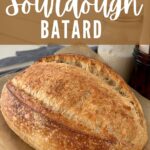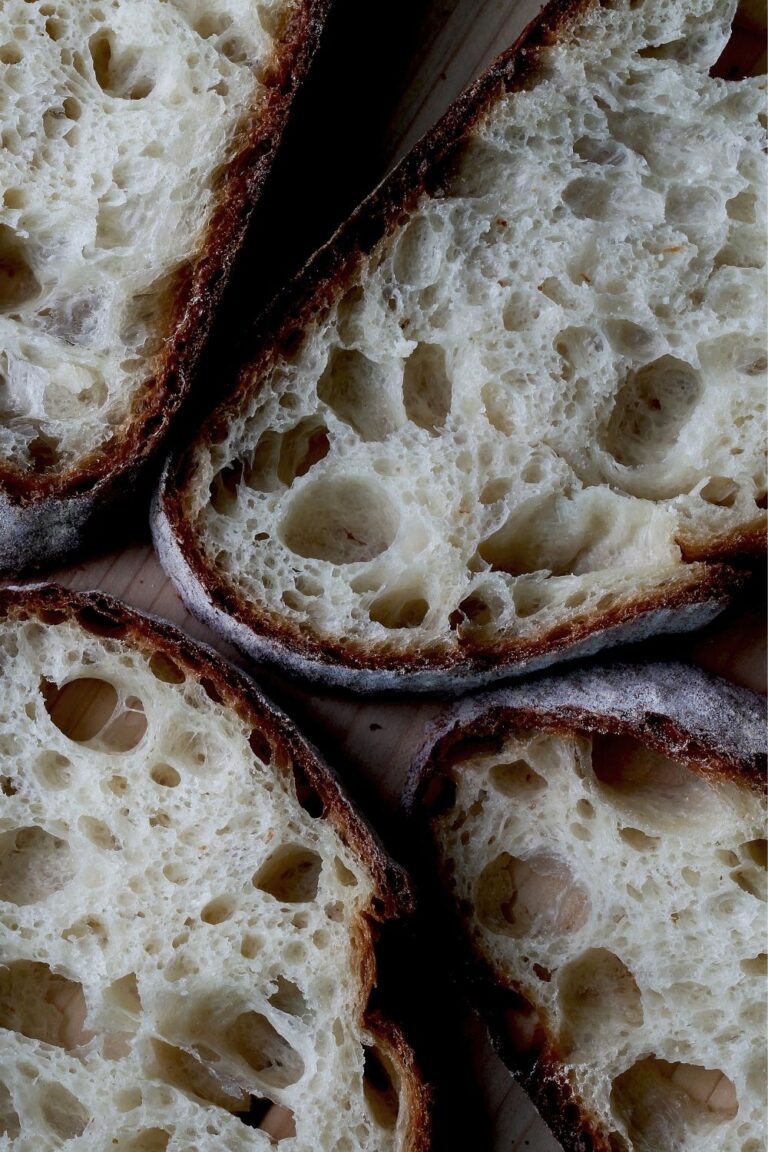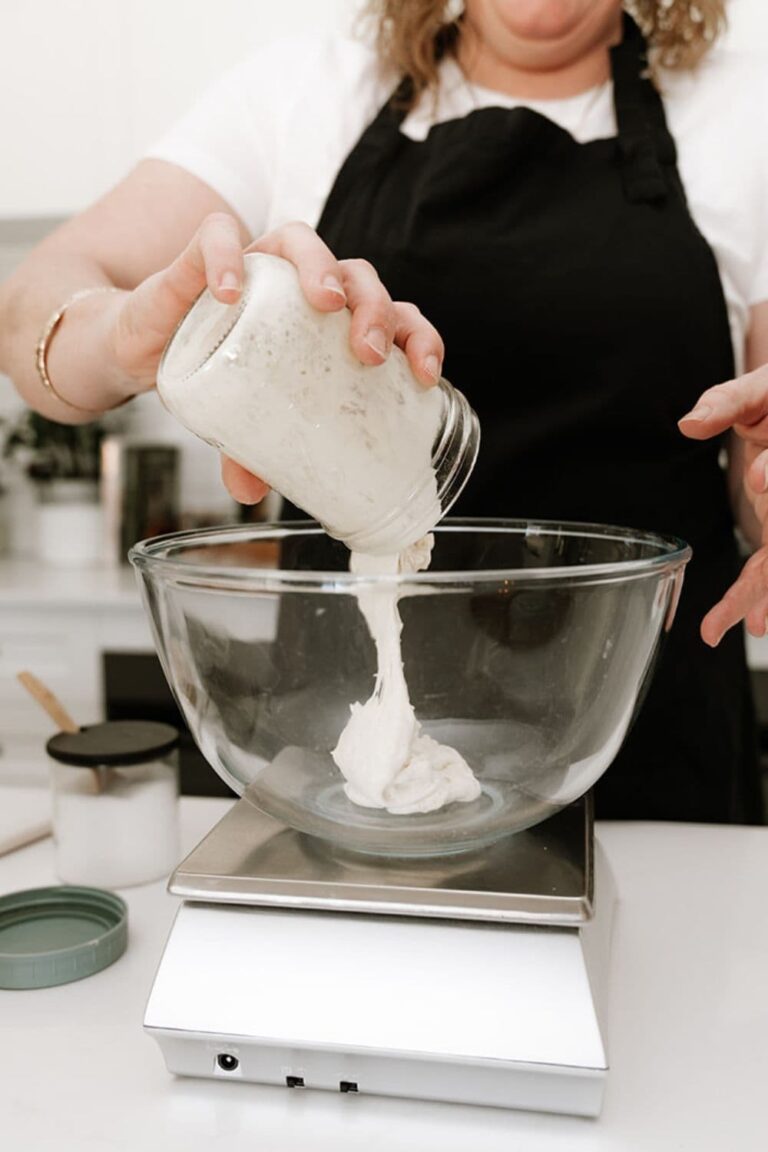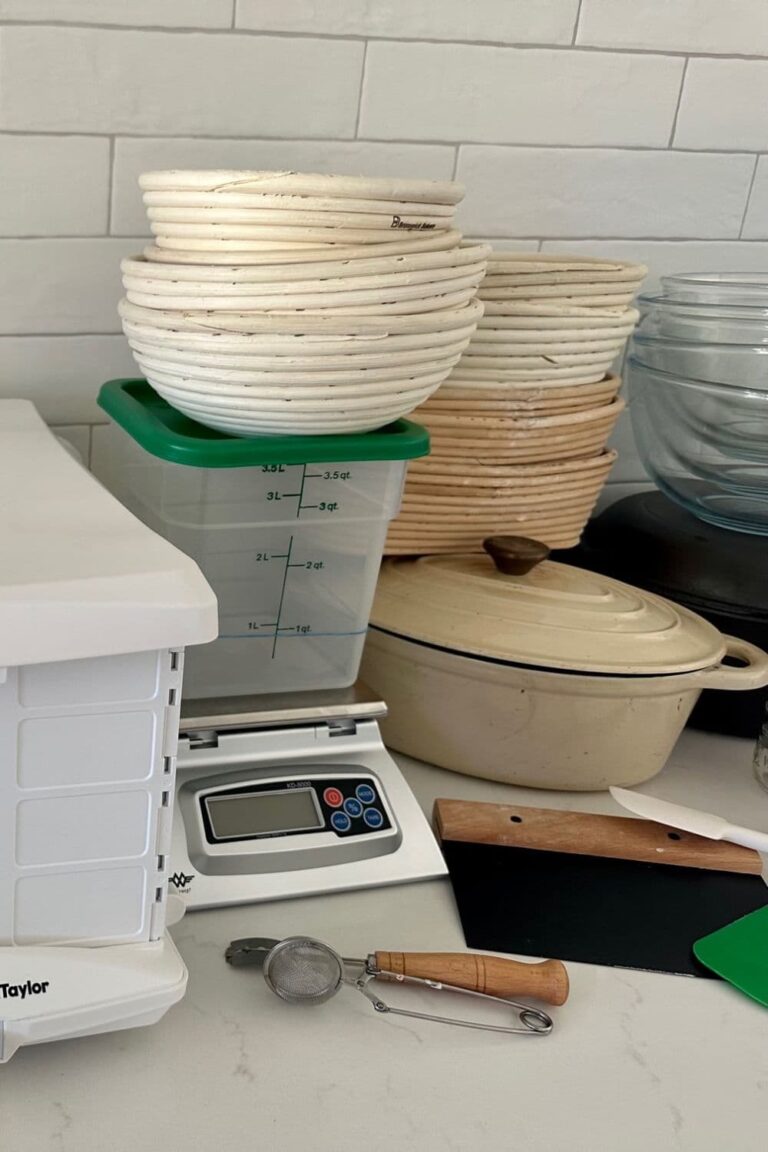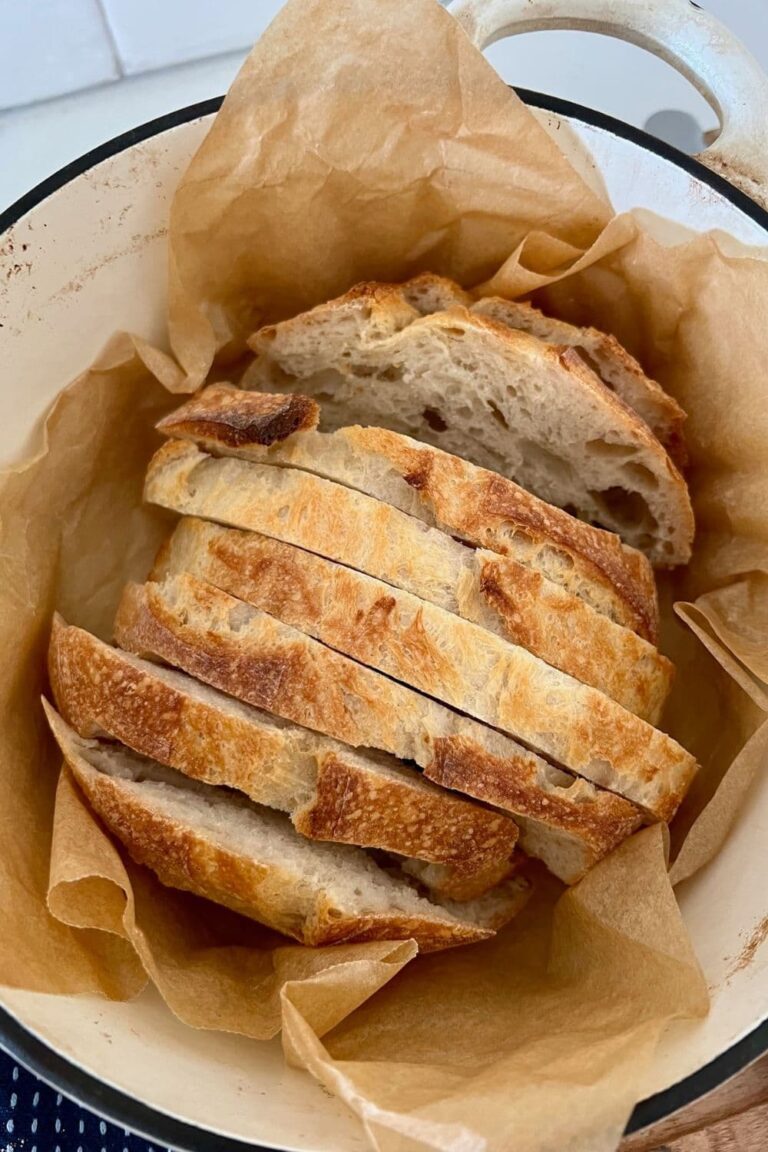How To Shape A Sourdough Batard - The Easiest Technique Ever!
This post may contain affiliate links.
Once you've mastered a simple sourdough boule, a sourdough batard is a nice sourdough shape to master. A sourdough batard is simply an oblong or oval shaped loaf of sourdough that is shaped and placed into a longer banneton or basket for its final proof. Batards can be easier to slice and a more manageable size for sandwiches, making them the perfect loaf.
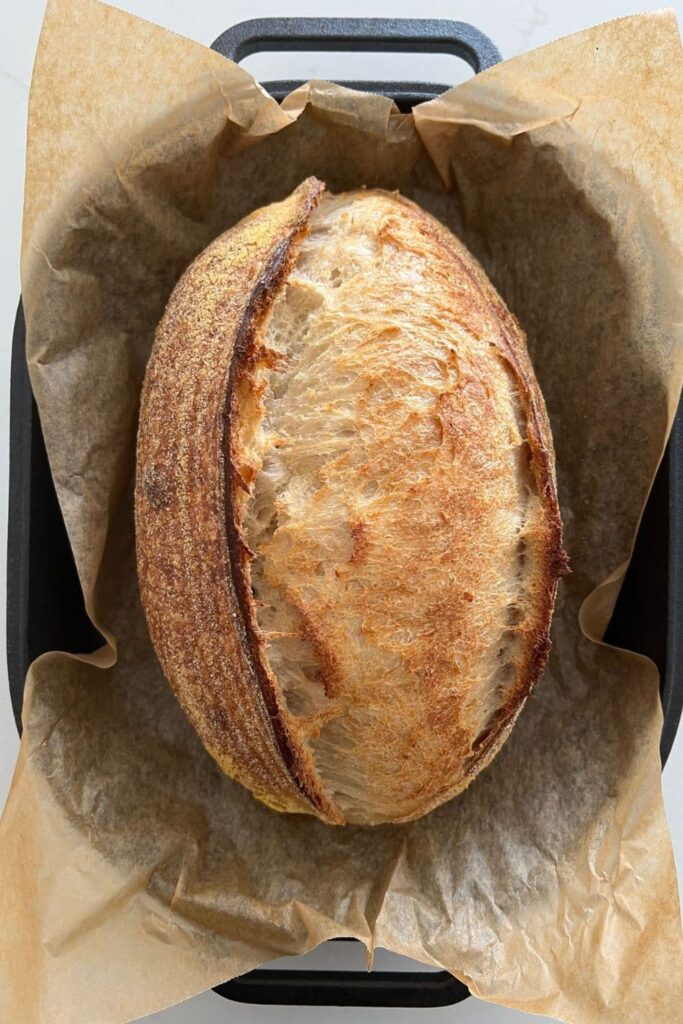
Shaping a sourdough batard is quite easy as long as your dough has finished bulk fermentation and is ready for shaping. Under or over fermented dough make it much harder to build the oval shape with the bread dough.
I've put together a simple shaping video for a sourdough batard below. The dough in the video uses my simple sourdough recipe exactly, but I've also added a recipe card to the bottom of the post if you'd prefer to follow along with that.
The most important thing to remember when shaping a sourdough batard is ensuring that you build structure by layering the dough onto itself and then tighten it to build surface tension, which will give you the best oven spring. You want a taut skin on your dough to ensure it holds in all those beautiful bubbles of gas. This taut skin will also help it not to stick to the banneton during cold retard (cold proofing).
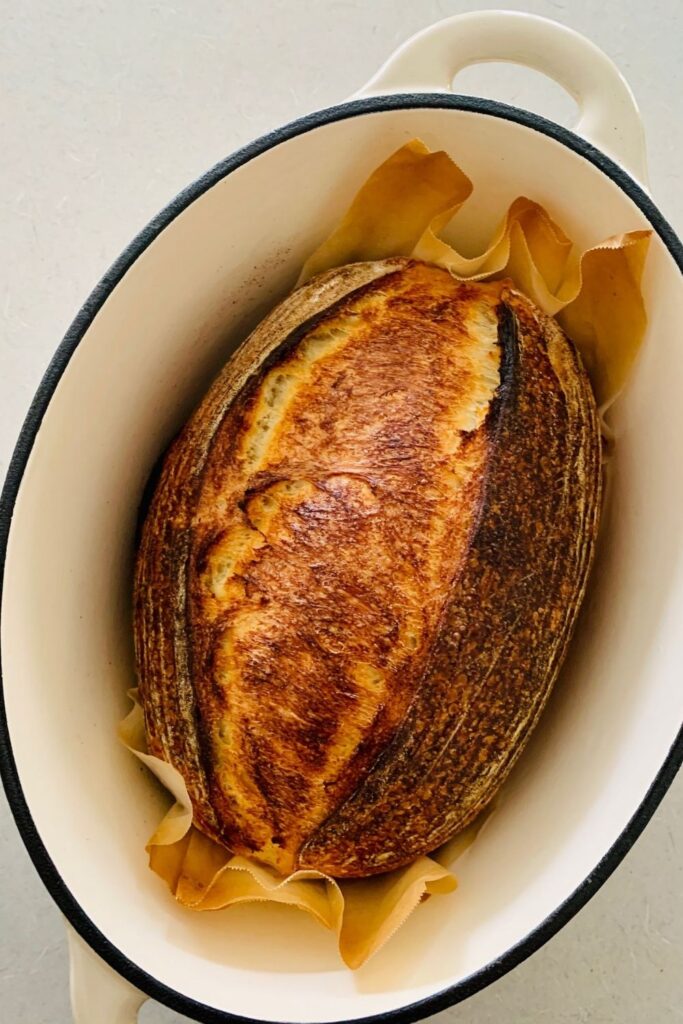
Why Shape Sourdough Into A Batard?
Sourdough that has been shaped into a batard is a popular bread shape because:
- Better shape for sandwiches than a round boule
- Allows to bake loaf pan sourdough bread
- Gives great oven spring with a round belly
- Easy to score for a sourdough ear
- Easier to slice into uniform slices
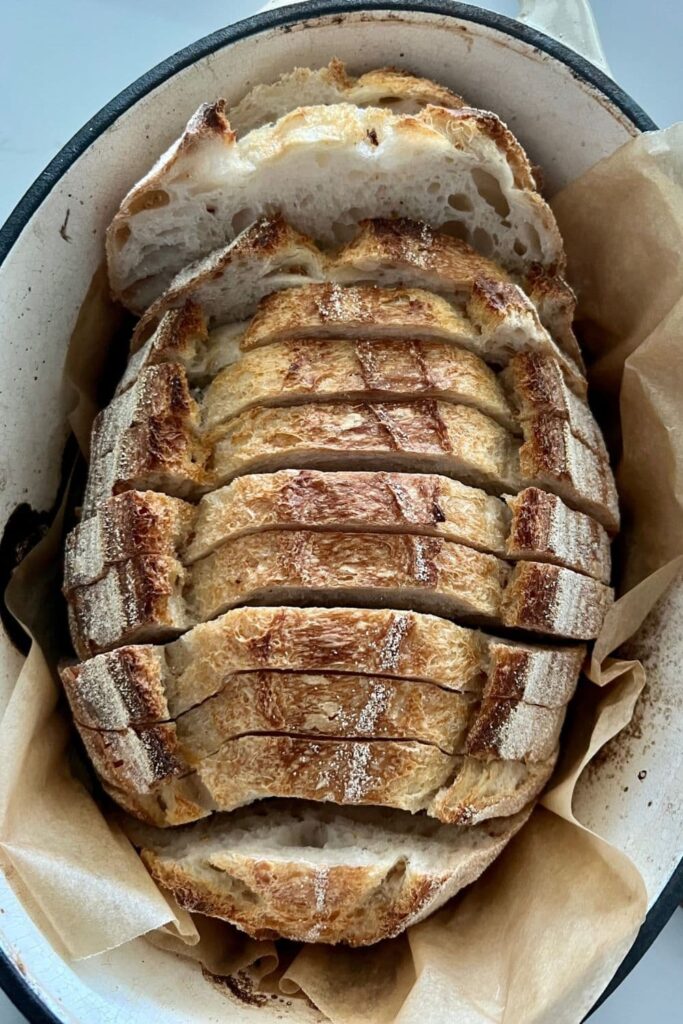
What is the Difference Between Sourdough and a Batard?
Sourdough refers to the type of bread and batard is a French term that refers to the shape of bread, so there's no real difference because in fact, you can have a sourdough bread that is shaped into a batard, meaning sourdough can be a batard and a batard can be sourdough!
In general a sourdough batard refers to a lean sourdough bread, with no fats, oils or sugars, that has been shaped into an oval or oblong and then placed into a proofing basket to rest and proof (whether on the counter or in the fridge). You can use lower hydrations (like a sandwich loaf) or high hydration doughs when shaping a batard.
What Equipment Do I Need For Shaping & Baking A Sourdough Batard?
If you choose to bake a sourdough batard, you'll need an oval shaped banneton and an oval shaped Dutch Oven.
You need to make sure that your banneton fits inside your Dutch Oven with about 1 inch around the edges. If you have a round Dutch Oven, you'll need to make sure you use a smaller banneton to fit the shaped oval dough inside.
If your banneton does not fit inside your Dutch Oven, then your shaped dough will not fit.
I generally bake sourdough batards inside my cast iron bread pan and my oval Dutch Oven. I can also fit a small sourdough batard inside my Lodge Double Dutch Oven (as long as it's shaped tightly).
If you don't have an oval banneton, you could proof your batard in a loaf tin or find other proofing basket alternatives here.
I've put this information in the table below:
| DUTCH OVEN | SIZE | BANNETON SIZE |
|---|---|---|
| Oval Dutch Oven | 11.8" x 8.9" x 4.5" | up to 11" oval banneton |
| Cast Iron Bread Pan | 11.8" x 9.4" x 5.5" | up to 11" oval banneton |
| Lodge Double Dutch Oven (round) | 12.5" x 10.3" x 6.5" | no bigger than 10" oval banneton |
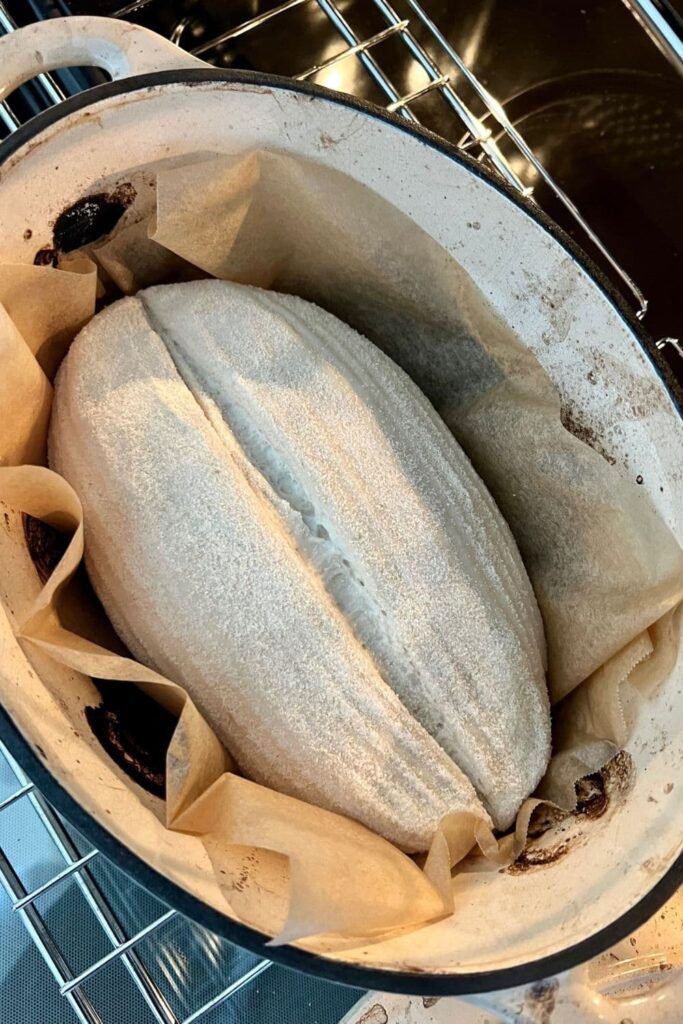
Can You Bake A Sourdough Batard Without A Dutch Oven?
Yes you can bake a sourdough batard without a Dutch Oven. You will need to use a baking stone or pizza stone or even just a heavy cookie sheet or baking tray (one without a lip around the edge is best).
The trick to baking a batard without a Dutch Oven is creating enough steam inside the oven to give you good oven spring and a nice, crispy crust that's not too chewy.
You can find my guide to baking sourdough without a Dutch Oven here.
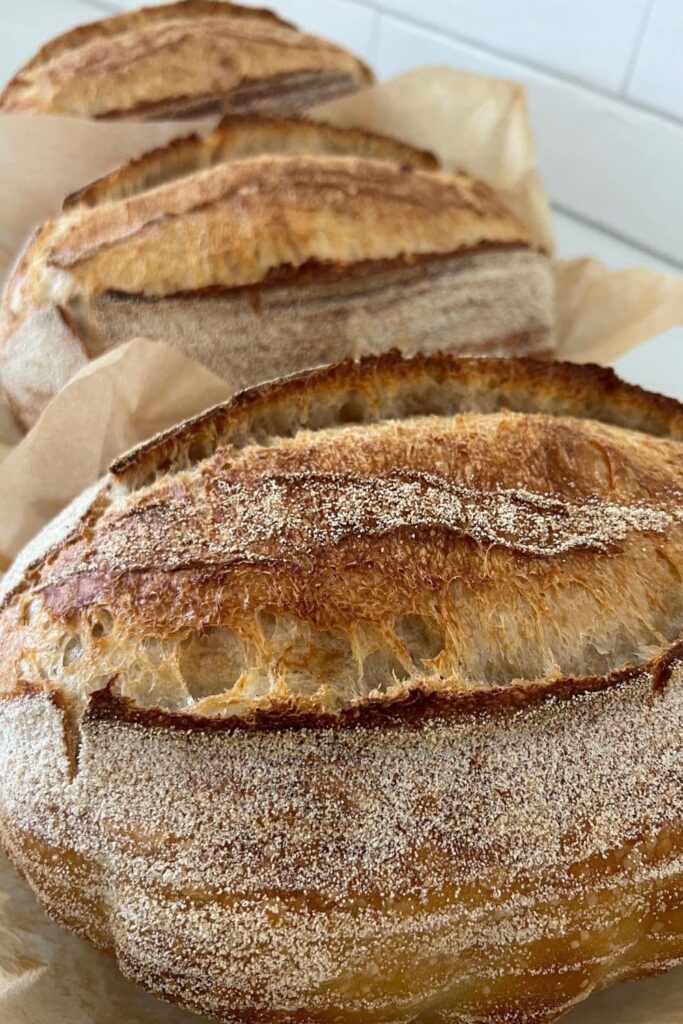
How To Shape a Sourdough Batard (Easiest Technique Ever)
Shaping a sourdough batard doesn't take long and the more you practice, the better you'll get! Making small batch sourdough loaves are great if you're looking for smaller practice loaves for your homemade sourdough bread.
Here's how to shape a sourdough batard:
- Lightly dust your countertop with rice flour (as you get better, you probably won't need any flour at all).
- Sprinkle a little rice flour into your oval banneton.
- Make sure you have clean, dry hands (you don't want wet hands for shaping or you'll end up with a big mess on your hands).
- Use a plastic dough scraper to ease the sourdough out of the bowl and flip it onto the counter top so that the sticky, underneath of the dough ends up on top and the smooth side is on the counter (this will help you manoeuvre your dough much more easily).
- Use your hands to gently ease the dough out into a rough rectangle, with the short side opposite you.
- Now, flip the top of the rectangle down.
- Take the right side of the dough and flip it in and then do the same with the right side. This is creating structure in the dough.
- Now pick up the bottom of the rectangle and gently roll it upwards, creating surface tension as you come to the top.
- As you reach the top, gently roll the batard so that the seam is positioned underneath.
- Now, tighten the surface of the dough by gently putting your hands on the back of the dough and pulling it towards you without taking it off the counter.
- Now pick up the dough and flip it into the floured banneton with the seam at the top.
- Use your fingers to bring the base of the dough together to create a tighter seam if you need to.
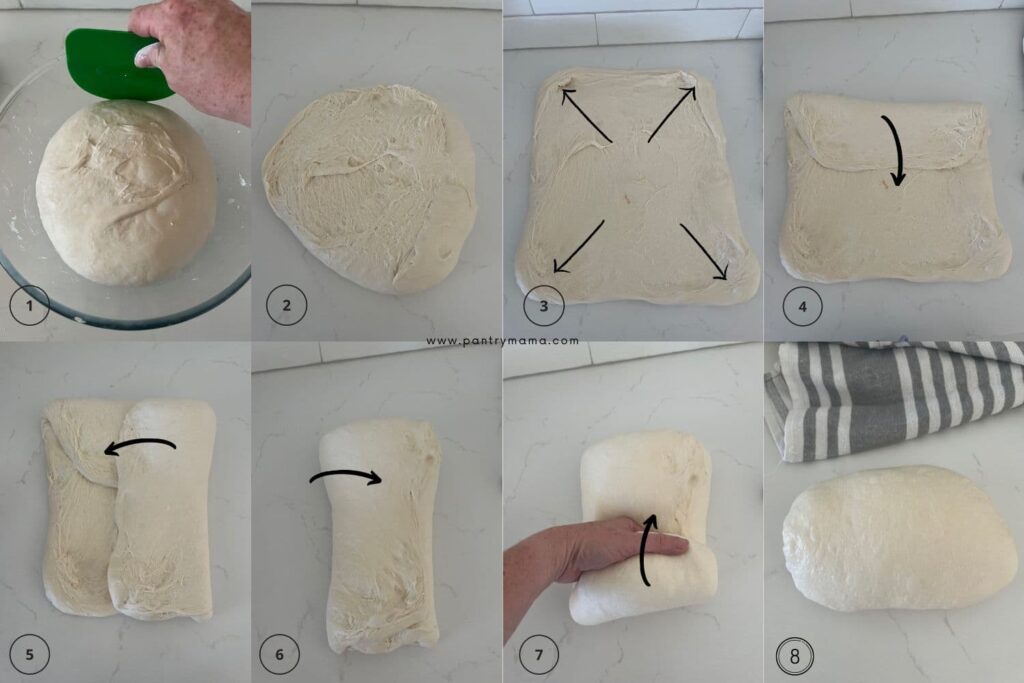
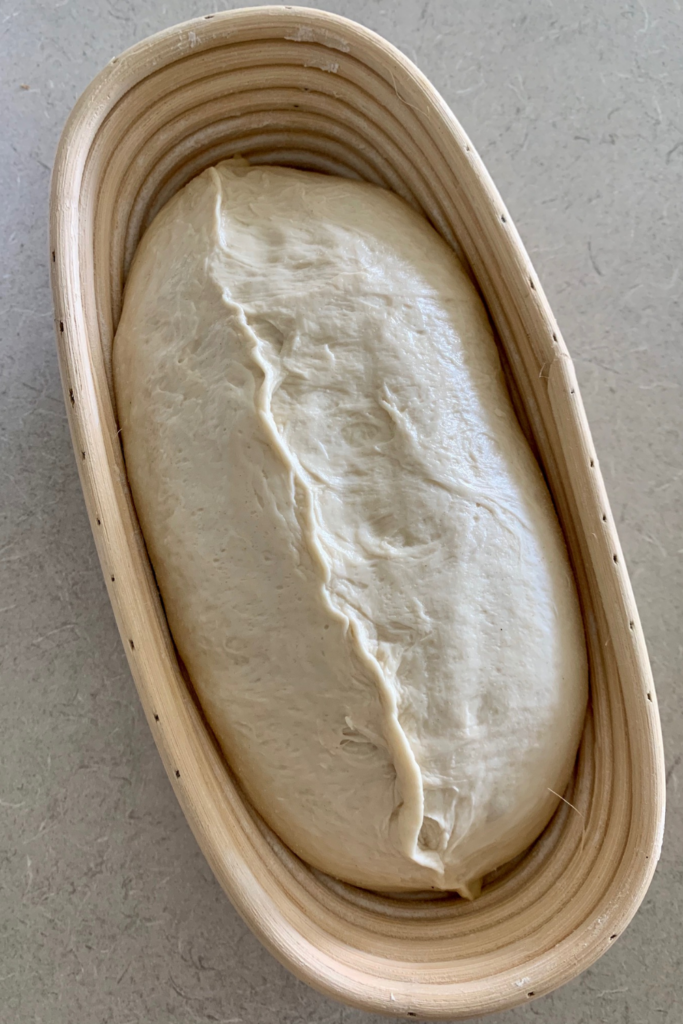
Will I De-Gas My Dough If I Over Handle it?
One of the most common questions I get asked about shaping a sourdough batard is whether the dough will "degas" when you shape it.
Shaping a sourdough batard requires you to handle the dough a little more than a traditional boule, however, as long as you are gentle with it, you should retain the bubbles.
If you feel that your dough is a little dense once it's shaped, it's a good idea to leave it on the counter top in the banneton just to rise a little before you place it in the fridge for it's cold ferment.
Allowing your dough to relax in the banneton before placing it in the fridge for cold proofing can help with the finished shape of your batard.
Just remember that when you place the dough in the fridge, it will keep fermenting until the dough gets down to a colder temperature.
You can read more about cold fermentation vs bulk fermentation here.
How Long Should Sourdough Rise Before Shaping?
This question is difficult to answer without knowing specifically the amount of sourdough starter you're using, the ratio of starter to bread flour (or other flour) and what temperature you are bulk fermenting at (room temperature), as well as the temperature of your dough. Sourdough is not something you can measure by time, but rather by the feel of the dough.
As a general rule, when the dough has doubled, this signals the end of bulk fermentation. The dough will be pillowy and cloud like, a good gluten structure that allows you to build surface tension. The top of the dough should not be sticky, which allows you to work more easily with the dough during the shaping process.
How To Shape A Sourdough Batard Video
Some Recipe Ideas For Sourdough Batard
While most recipes can be shaped in any way you like, there are certain types of sourdough recipes that lend themselves to a batard. My favorites are:
- Multigrain Sourdough
- Rustic Sourdough Bread
- Coffee & Maple Infused Date Sourdough
- Easy Whole Wheat Rye Sourdough Bread
- Lemon & White Chocolate Sourdough Bread
- Easy Pumpkin Sourdough Bread
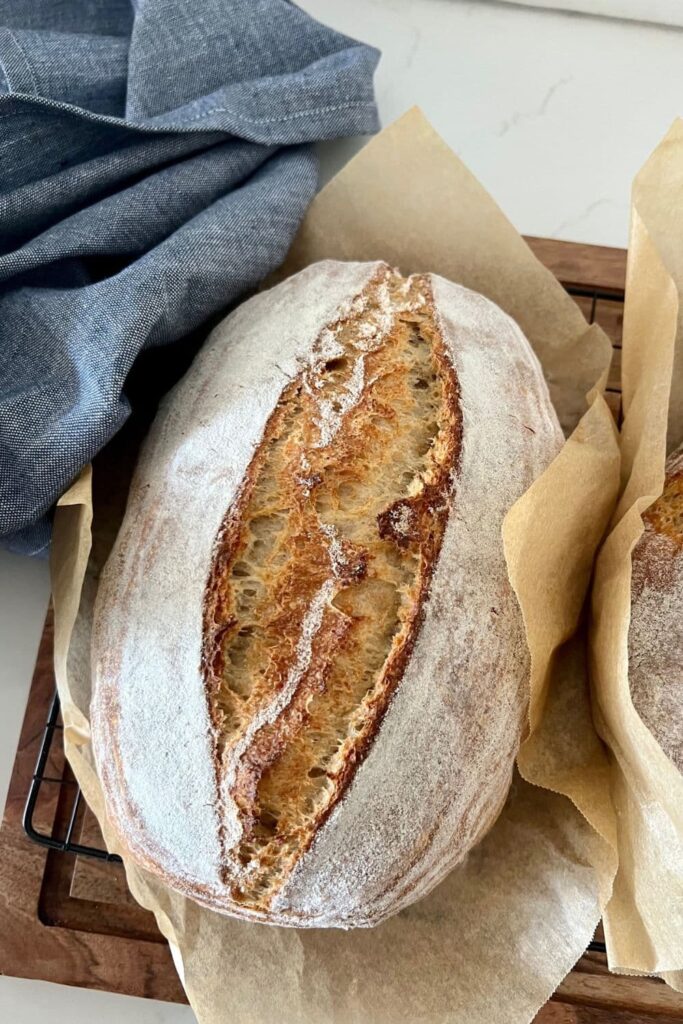
Frequently Asked Questions
Shaping a sourdough batard is super easy once you know how - and if you want to make it even easier, you can place it into a loaf pan after shaping. This is a great solution if you are still working on your shaping technique, or you're worried your dough is a little sticky or over fermented. The loaf pan will support the dough as it proofs and while it bakes.
No, you don't have to adjust the baking time for a sourdough batard. I bake a batard for the same amount of time as a boule, mainly because they use the same amount of flour, water and starter. You can adjust it if you have increased or decreased the dough weight.
Yes you will need an oval banneton to proof a sourdough batard. You can buy these from kitchenware stores or online. You could also use a loaf tin to proof an oval shaped loaf.
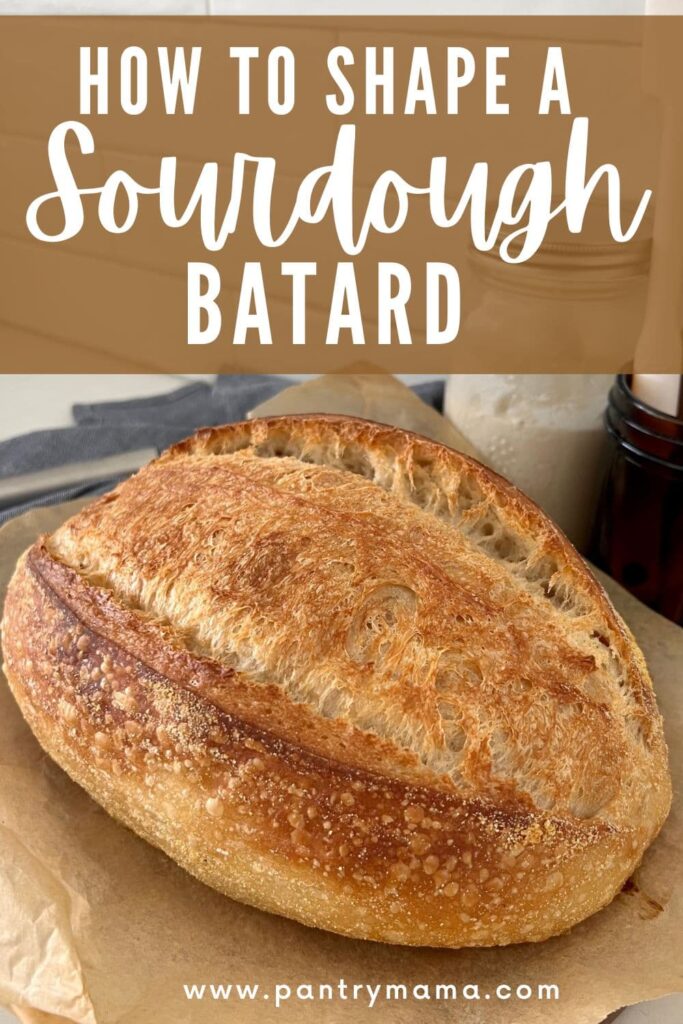
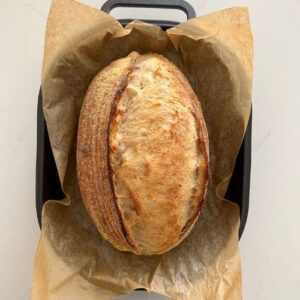
Easy Sourdough Batard Recipe
Equipment
- Mixing Bowl
- Digital Scales
- Oval Banneton (see notes below for size options)
- Oval Dutch Oven (see notes below for size options)
Ingredients
- 500 g Bread Flour
- 350 g Water
- 100 g Sourdough Starter
- 10 g Salt
Instructions
PREMIX THE DOUGH
- Weigh out your sourdough starter and water into a large mixing bowl and mix together briefly.
- Now add your flour and salt and mix whole lot together to form a dry dough.
- Cover your bowl with cling film or a damp tea towel and let it sit for around 1 hour. This process is called the "autolyse" and allows your flour to soak in all the water and become hydrated. You can see how the dough has changed in this photo.
FORMING UP THE DOUGH
- Bring the dough together into a ball. Pull the edges of the dough into the centre until it's smoother and more formed.You'll notice that the dough is fully hydrated after soaking all the water up. It will be fairly sticky but as you bring it into a ball, it will become smoother and shinier.
- Once the dough has formed into a smooth ball, pop the cling film back on and let it rest for 30 minutes.
STRETCH & FOLD PHASE (STRENGTHENING PHASE)
- Over the next few hours you need to create some structure for your dough by "stretching and folding". Aim to do around 4-6 sets of stretches and folds. For each set, stretch the dough up and over itself 4 times. Leave around 15 minutes in between each set. Again you do not have to be exact with time, but you need to do at least 4 sets over 2 hours.
BULK FERMENTATION (RISE PHASE)
- Once you've finished your stretch and folds, place the cling film or damp tea towel back over your dough and let it rest and ferment (a plastic cover is a better option for this stage).
SHAPE THE DOUGH
- Once your dough has finished its first ferment, it's time to shape it so that it will fit into your oval bannton. You'll need to flour your counter top with rice flour for this (we use rice flour because it has no gluten). Try to be quite sparing with the rice flour, you only need a very light dusting. Semolina is also ok for this.Lightly dust your countertop with rice flour (as you get better, you probably won't need any flour at all).Sprinkle a little rice flour into your oval banneton.Use a plastic dough scraper to ease the sourdough out of the bowl and flip it onto the counter top so that the sticky, underneath of the dough ends up on top and the smooth side is on the counter (this will help you manoeuvre your dough much more easily).Use your hands to gently ease the dough out into a rough rectangle, with the short side opposite you.Now, flip the top of the rectangle down.Take the right side of the dough and flip it in and then do the same with the right side. This is creating structure in the dough.Now pick up the bottom of the rectangle and gently roll it upwards, creating surface tension as you come to the top.As you reach the top, gently roll the batard so that the seam is positioned underneath.Now, tighten the surface of the dough by gently putting your hands on the back of the dough and pulling it towards you without taking it off the counter.Now pick up the dough and flip it into the floured banneton with the seam at the top. Use your fingers to bring the base of the dough together to create a tighter seam if you need to.Lift your dough around the edges to pop a little more rice flour if you feel it needs it. Just try to handle the dough as little as possible and be really gentle as you really want to preserve all the gases and air bubbles that have formed during your bulk ferment.
PROOFING
- Now you need to allow your dough to proof - we generally do this in the fridge. Place an elastic food cover over your dough (shower cap) and place it into the fridge.Try to leave it in the fridge for a minimum 5 hours up to a maximum of around 36 hours. The longer you leave it the better your bread will be! A longer cold ferment creates beautiful blisters on your crust and a deeper sourdough flavour. It will also ensure your dough forms a skin which makes it easier to score.
PREPARE TO BAKE YOUR DOUGH
- Once you're ready to bake your sourdough, you'll need to preheat your oven to 230C/450F.Place your Oval Dutch Oven into the oven when you turn it on so it gets HOT. Leave your dough in the fridge until the very last minute - placing a cold dough into a hot oven will give you a great "spring".
BAKE YOUR SOURDOUGH BREAD!
- When your oven is at temperature, take your sourdough out of the fridge. Gently place it onto a piece of baking paper.Make sure that you make the baking paper big enough to use the edges as a handle to lower to dough into your Dutch Oven.Gently score your bread with a lame, clean razor blade or knife. At minimum a large cross is sufficient, but you can get as artistic as you like. You can find my full guide on how to score sourdough bread here.Carefully take your dutch oven out of the oven. Place the sourdough into the pot using the baking paper as a handle. Put the lid on and place into the hot oven.If you want to you can spritz your dough with extra water before you put the lid on.BAKE TIME:30 Minutes with the lid on at 230C/450F plus10-15 Minutes with the lid off at 210C/410F
LET YOUR BREAD COOL
- When you remove your dough from the oven, carefully remove it from the dutch oven as soon as possible and place on a wire rack to cool.
Notes
- Notes on Flour: This recipe is written using strong Bread Flour. Bread flour has a higher protein content than All Purpose flour. If you choose to use All Purpose flour you may have a different result because of this. You can read more about the differences between All Purpose Flour and Bread Flour here.
- Notes on Sourdough Starter: This recipe is based on you having an active starter that you have fed a few hours before starting your bake. For info on how to make a sourdough starter, go here.
- Notes on Stretch & Folds: If you are going to do the stretch & folds on your bench top, spray your surface with water mist rather than using flour. You can leave the dough in the bowl if you want to. Wet your hands to stop the dough sticking - although it shouldn't be too sticky. It will get less sticky as you do your stretches and folds. For more information on how to do stretch and folds, go here.
- Notes on Bulk Fermentation: If your home is warm then your dough will ferment a lot faster and could be done in as little as a few hours. If it's colder, it will take longer. You will know your dough is ready to move to the next stage when it has *just* doubled in size. It will be fairly wobbly and full of bubbles. You should be able to see large air bubbles under the surface of the dough.
You don't want to let it go any further than doubled as it will be over fermented.
You'll find more information on these topics here:
When is my bulk ferment finished? What is the difference between cold ferment and bulk ferment? Why does the amount of starter matter?
- Notes on Bannetons for Sourdough Batards: I have used an oval shaped banneton and Dutch Oven to bake this sourdough batard. Depending on what else is going on in my kitchen I use an Oval Dutch Oven or Cast Iron Bread Pan to bake my sourdough batards (but you can also find out how to bake a batard without a Dutch Oven here). The sizing details are: Oval Dutch Oven - 5Q or 5L (30cm x 22.6cm x 11.4 cm which equates to 11.8 x 8.9 x 4.5 inches) Cast Iron Bread Pan - (internal dimensions 30cm length x 24cm width x 14cm height which equates to 11.8" x 9.4" x 5.5" height). You can find my guide to the Best Dutch Ovens for Sourdough Bread here. Banneton - I use an 11" oval banneton to proof my batards. The only time I use a smaller one is if I want to bake a batard in my Lodge Double Dutch Oven. Then I use a 10" - I don't change the dough weight, I just shape it a bit tighter and it fits. You can find my full banneton sizing guide here.
